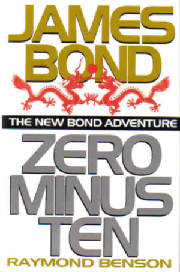 ZERO MINUS TEN. Raymond Benson. Putnam's; 1997.
Benson's first James Bond adventure takes place primarily in Hong Kong during the ten days before
the city is to be turned back to the People's Republic of China from the British Crown. A series of strange events occur that
all seem to be tied to the EurAsia Corporation owned by one Guy Thackeray. The entire board is killed when a floating restaurant
blows up; their legal adviser is assassinated; and out in the Australian outback someone sets off a nuclear device on property
owned by the corporation. Thackeray, who cheats at mahjong, seems to be the chief suspect until he's blown up in his car by
another bomb. Other major players include the head of a Hong Kong Triad (a sort of Chinese Mafia), Li Xu Nan; a California-raised
Chinese gal, Sunni Pei, who works for the Triad in one of their sexy clubs; and General Wong, who
is one link in a major drug operation and who tortures Bond with blows from a cane in an excruciating sequence. The action
briefly switches to the Outback where Bond investigates a sinister mine, and the climax features a desperate hunt for a nuclear
device in the congested Hong Kong harbor. While the villain is not quite classic, he is a truly loathsome creature and memorable
for that reason. In some ways Zero Minus Ten isn't quite as good as the best of Gardner's
– or Fleming's – novels, but it is generally an excellent story with a lot of suspense and many exciting moments.
The book is bolstered by the background of the political situation in Hong Kong, as well as the characterization of Sunni,
who is, perhaps, a more dimensional Bond “Girl” than usual. The plot is a little more complex and “historical”
than Gardner's.
There are a couple of dumb moments. Although Sunni is a modern heroine who can defend herself
and fight well, it makes no sense that Bond brings her along during one part of the mission; when both are captured even Bond
is annoyed with himself. When Bond asks a captor to let him stretch because he's in pain, you have to wonder why the bad guy
let's him do so when he intends to kill him in just a short while. Why should he care if Bond's in pain?
The Double 0 designation is back in use, as revealed in a prologue training exercise for Bond
and two other Double 0 operatives. Some of the banter in the book is reminiscent of dialogue in the movies. Ann
Reilly, or Q'ute, has been sent on her way and Major Boothroyd is back to
being the head of Q Branch.
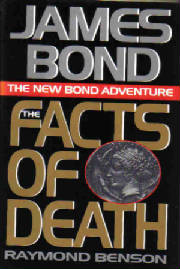 THE FACTS OF DEATH. Raymond Benson. Putnam's; 1998.
James Bond takes on the Decada, a terrorist group which bases its actions on Pythagorean theories,
in a story tied to the conflict between Greeks and Turks over the island of Cyprus. The group commits atrocities and leaves
behind numbers and little statues. The novel in particular has two interesting villains in the Monad, head of the Decada,
who is named Konstantine Romanos; and his Number Two, a deadly female named Hera Volopoulos, who at one point threatens to
dissect Bond with a knife while he's still alive. While these two are not quite of classic stature [in fact, the Bond stories
have never really had a major villainess], they are certainly colorful and dangerous antagonists. Bond also has to deal with
their associates Ashley Anderson, who runs a sperm bank as a cover, and the hulking Vassilis, who has a notable battle with
Bond in the dark of an old tomb. Benson makes good use of exotic locations in his story.
Bond's partner for much of the book is Niki Mirakos of the Greek National Intelligence Service.
M – Barbara Mawdsley – falls in love with a beloved British figure named Alfred Hutchinson, who is murdered and
whose ne'er-do-well son is involved in the Decada. Felix Leiter appears briefly with his girlfriend Manuela Montemayor in
scenes that take place in Texas. Bond thinks of himself as having a “lonely, wretched life” although he keeps
women at bay [aside from for sexual purposes] probably because of all the women he loved and who died, including his only
wife, Tracy. Bond recalls a rather ugly line from Felix Leiter: “women are like stamps
– the more you spit on them, the more they get attached to you.”
Just as John Gardner added psycho-sexual elements to his second Bond novel, For Special Services, Benson does the same for his second Bond book by creating a kind of lesbian conspiracy inside
the Decada, three women who are intimately involved and who wish to take over the group for their own purposes [creating an
epidemic so that they can make millions by selling a cure]. It's not so much that this [downplayed] element of the book is
homophobic as that it's kind of hokey and pointless. Additionally, by suggesting that Hera hates men because she
was repeatedly molested by the Monad since girlhood goes against modern-day theories about homosexuality. Sexual orientation
is supposed to be determined in the first few years, if not at birth, so a woman wouldn't become gay simply because of bad
experiences with men in her youth. [It's also a cliché to suggest that gay women hate men.] Apparently, Benson isn't much
more sophisticated on the subject than Ian Fleming – or John Gardner – was. Still, The Facts of Death shouldn't be considered anti-gay, as this aspect of the story is not really explored with any
depth, and may have been included just for extra “titillation.”.
There are elements in the novel that seem more influenced by the James Bond
movies than by Ian Fleming, including Bond's almost ridiculously souped-up car, his casual attitude toward death [he uses
the car's technology to kill several pursuers in rapid succession] and his frequent bed-hopping – Fleming certainly
gave Bond numerous sexual episodes but perhaps not so many in a single book. Fleming's and Gardner's Bond may have killed
when it was necessary, but it was never done casually or without having some -- even if belated -- effect on 007.
Whatever its flaws, The Facts
of Death is an entertaining, frequently exciting and suspenseful Bond adventure.
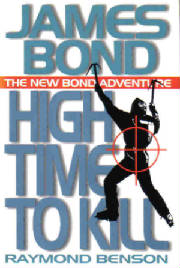 HIGH TIME TO KILL. Raymond Benson. 1999.
Benson's third Bond adventure introduces a kind of rough-hewn SPECTRE in The Union, who are
also terrorists for hire [“their tactics were more guerrilla oriented,” notes Bond.]. The Union is run by a blind
man named Le Gérant. A British scientist has developed a formula for Skin-17,
which will enable planes to fly at even greater speeds without breaking apart in mid-air. Unfortunately, the Union also desire
the formula, which they plan to sell to the Chinese. The Russians are after it, as well. The only copy of the formula winds
up on a microdot inside a pacemaker of a middle-aged Chinese agent who, after a series of double-crosses, winds up on a hijacked
plane that crashes into a peak of Kangchenjunga, a high mountain in Katmandu. It's Bond's job to accompany a team who are
climbing the mountain purportedly to salvage the plane and retrieve the bodies of the passengers; Bond's only objective, of
course, is to retrieve the microdot. But not only are there disguised Union agents and Russian agents among the large group,
but the leader of the expedition, an old schoolmate of Bond's named [Group Captain] Roland Marcus is a traitor [This is established
quite early in the book, minimizing some of the suspense, although there are still some surprises as to the identity of other
bad guys].
In this book Bond continues, and tries to end, a personal and sexual relationship with his personal
secretary, Helena Marksbury, which began in the previous novel. One senses that Bond is a little put-out that Helena's air
of preoccupation and upsetment has to do with a much more serious matter than the end of her affair with Bond. The Bond-Marksbury
relationship comes to a dead serious wind-up at the end of this story. M is not pleased with these developments, and neither
is Bond. Marksbury is in some ways an even more pitiable figure than Vesper Lynd in Fleming's Casino Royale. .
Benson continues to be influenced by the Bond movies, with another ludicrous scene wherein Bond
uses his souped-up car to destroy some pursuers on the highway, endangering dozens of innocent motorists, and sex scenes that
seem dragged in to satisfy some kind of quota. The Bond ladies of the story include Gina Hollander, an agent in Brussels,
and the much more memorable Dr. Hope Kendall, who manages to save Bond's butt when he completely collapses high in the Himalayas.
She was – or is – a self-confessed sex addict and sometime bisexual. Bond is also assisted by a Nepalese Gurkha
named Sergeant Chandra Bahadur Gurung, and Benson spends some time developing this likable character and bringing him into
the action. In fact, Bond sorts of drops out of the action for a short while and the Gurkha takes over.
The early chapters of High Time to Kill detailing the theft of the Skin-17 formula, and the machinations of The Union, etc., really pull
you in. The novel's second half detailing the dangerous trek to the plane wreck is more deliberately paced but undeniably
harrowing at times. While this is somehow not as good as Benson's first two 007 novels, it is still a solid Bond adventure
with a few missteps and a lot of interesting additions to the Bond mythology.
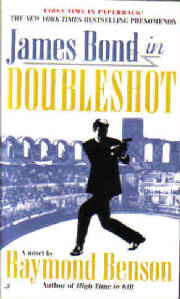 DOUBLESHOT. Raymond Benson. 2000.
From injuries sustained during his adventures in the Himalayas in High Time to Kill,
Bond develops severe headaches and other complaints that have him seeking medical attention. But his headaches get worse and
turn into apparent hallucinations and black-outs. It seems that Le Gerant and The Union want revenge
against Bond for his role in the Himalayas and have decided to use a plastic-engineered double of Bond to turn him into an
assassin of innocents and ruin his reputation. First, they try to frame him for the murder of his beautiful psychiatrist,
Dr. Kimberly Feare. As usual, Benson employs a volatile political background, in this case the tensions over the British rule
of Gibraltar, to bolster his story. Chief among those who wish Gibraltar returned to Spain is famous bullfighter Domingo Espada, one of the most loathsome supporting villains in all Bond literature. Espada is a loyalist who wants
Gibraltar back no matter what the cost, but he also traffics in young women and girls who are taken from poor homes and turned
into unwilling prostitutes. Espada murders anyone who gets in his way, employing the deadly female known as the “preying
mantis,” Margarita Piel. These two infamous individuals are soon allied with The Union in an
attempt to retake Gibraltar, assassinate important political figures, and destroy the hated James Bond.
For his part, Bond wants to track down the murderers of his former secretary/lover,
Helena Marksbury, which leads him to a porn shop in Soho and then to Casablanca and the HQ of The Union. This book provides
more background on both The Union and its Berber-Corsican-Parisian leader Le Gerant, Olivier Cesari. The Bond double's real
name is Peredur Glyn. When Bond pretends to be his own double, he – the roue! -- can't resist making love to the evil
Margarita, who realizes that his – ahem – penis isn't quite the same as Glyn's. This leads to a very
tense finale at a meeting of minds in Gibraltar. The book begins and ends with this exciting sequence which doesn't work out
quite the way anyone intends it to.
This is a very entertaining, nearly top-notch Bond adventure. Frankly, the
identical twin blond CIA agents Heidi and Hedy are never very believable and don't really add anything to the book but a few
winks and leers. The Spanish bullfighting milieu, however, whatever its merits or lack of same, adds a lot to the book, including
a death in the arena, and Bond being forced to fight a bull maddened by pain in Espada's private bullring.
Bond enjoys a dish of panache de briouates aux crevettes, puff pastries
stuffed with shrimp and chicken, as well as tagine de kebab maghdour aux oeufs, a combination of meat, paprika sauce
and eggs.
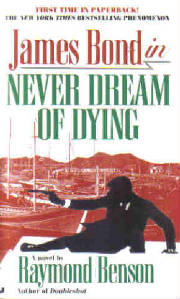 NEVER DREAM OF DYING. Raymond Benson. 2001.
Bond comes afoul of The Union and its sinister blind head Le Gerant again in this adventure which centers on The Union's
involvement in the film industry. Film director Leon Essinger and his estranged wife, the improbably-named Tylyn Mignonne,
get involved with the super-criminal organization when they go into business with the former. Bond masquerades as a film reporter
to get close to the rather one-dimensional sex bomb Tylyn and develops what seems like a school boy crush on her. Learning
his wife plans to leave him, Essinger has no problem in helping The Union in its plan to blow up many celebrities –
including Tylyn -- at the Cannes Film Festival!At the opening of the book Bond commits an act in trying to capture some Union
members that inadvertently leads to the fiery deaths of a number of innocent people; this embroils an unexpected party from
Bond's past in a surprising manner.
Never Dream of Dying isn't a bad book, but somehow it
just isn't top-notch Bond. The movie set/special effects background should add to the book but somehow makes it seem more
superficial than usual. The relationship between Bond and Tylyn is never really believable. A scene where Bond unnecessarily
creates havoc in a television studio smacks of something out of one of the sillier Roger Moore movies and is one of the worst
scenes ever written for a Bond novel; Ian Fleming would have been appalled! Bond appears to hate Paris [due to negative youthful
experiences] as much as he loves New York. We learn that Le Gerant's favorite piece of music is Rimsky-Korsakov's Scheherazade. Bond's former father-in-law Marc-Ange Draco shows up at a couple of unexpected moments. Captured
by Le Gerant, Bond is tortured by a sadistic associate who uses lasers on his eyes. Okay, but not top-notch by any means,
even for Benson.
 THE MAN WITH THE RED TATTOO. Raymond Benson. 2002. Benson is back in top form with this, his (unfortunately)
final Bond novel to date. In this exciting and suspenseful entry 007 takes after the terrorist who employed The Union in the
previous Bond book, Goro Yoshida, who has strong ties to the Yakuza. Goro and his followers, who want Japan to become more
traditional in the worst way, are obsessed with the writings and philosophy of Japanese writer Mishima. One of Goro's associates
is a dangerous midget named Junji Kon whose nickname is Kappa, a kind of Japanese demon. The storyline has to do with Yoshida's
attempt to use mosquitoes carrying a particularly lethal form of west Nile virus to not only wipe out the G8 conference attended
by important politicians, but attack the United States with what might be called kamikaze agents. To help bring this about
Goro murders off a pharmaceutical king and his family, and tries to get to the last surviving daughter, the rebellious Mayumi,
so that he can retain interest in the company. Some of the little buggers get loose in a locked train compartment in one of
the book's best sequences; this leads to a desperate search for the escaped mosquitoes on the train itself, not to mention
Bond dangling from the ceiling of a tunnel in the direct path of an onrushing bullet train – a great sequence.
The climax with more mosquitoes escaping from their hiding places to attack the guests at the conference is wonderfully suspenseful
as well.
Bond is reunited with Tiger Tanaki of You Only Live Twice, and works with one of his
female agents, Reiko, who is killed. He also has a young male personal assistant named
Nigel. This is a terrific Bond adventure with some knock-out sequences, a strong plot, interesting adversaries and allies,
and it just about works every step of the way.
|